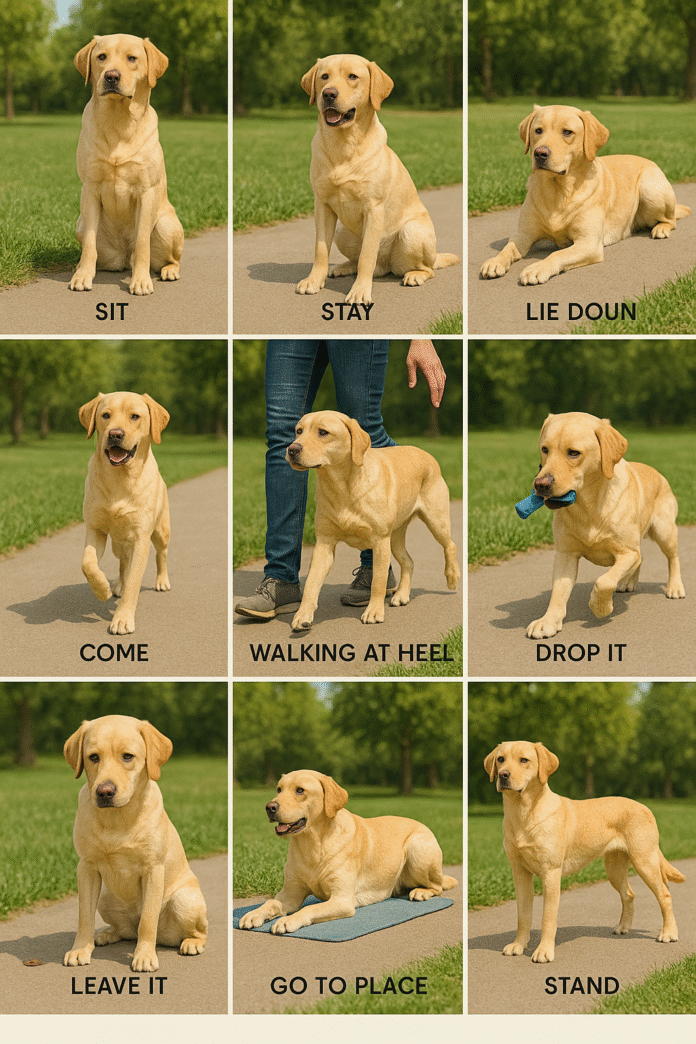Training your dog goes beyond tricks and entertainment—it’s about communication, safety, and mutual respect. Whether you’ve just adopted a new puppy or want to polish your older dog’s manners, teaching foundational commands is a must. In this guide, we’ll explore the 10 essential commands every dog should know, why they matter, and how to teach them effectively.
Why Basic Dog Commands Matter
Basic obedience training strengthens your bond, keeps your dog safe, and improves their behavior at home and in public. A well-trained dog is less likely to develop anxiety or behavioral issues, and is more likely to enjoy freedom (like off-leash time) safely.
1. Sit
Purpose: The “sit” command is one of the first and most foundational commands. It’s useful in many everyday situations, like calming your dog before a walk or meal.
How to teach it: Hold a treat above your dog’s head and slowly move it backward. Your dog’s bottom will automatically drop as its head tilts upward. Once seated, say “sit” and reward.

2. Stay
The “Stay” command is crucial for your dog’s safety and helps them remain still, especially in busy or dangerous environments.
How to teach it: Ask your dog to sit, then say “stay” while showing a flat palm. Step back slowly. If your dog doesn’t move, reward and praise. Gradually increase the distance.
3. Come
Purpose: Helps recall your dog when off-leash or in risky situations.
How to teach it: Start indoors. Say “come” in an upbeat voice while gently tugging on a long leash. Give your dog a reward or some praise when they return.
4. Down
Purpose: Encourages calmness and is especially useful for overexcited dogs.
Holding a treat above your dog’s nose, gradually lower it to the ground while training. Give your dog a treat when they lie down after you say “down” and they follow.

5. Leave It
Purpose: Teaches your dog to ignore distractions or dangerous objects.
How to teach it: Place a treat in each hand. Show one and say “leave it.” When your dog ignores it, reward with the treat in the other hand.
6. Drop It
Purpose: Useful if your dog grabs something dangerous or inappropriate.
Teaching tip: Give your dog a toy. Let them grab it, then offer a treat and say “drop it.” When they release the toy, reward immediately.
7. Heel
Goal: Makes walks more pleasurable by ensuring your dog walks peacefully next to you.
Using a leash and treats, lead your dog around your leg as a teaching technique. Say “heel” and reward when they walk calmly next to you.

8. Wait
Purpose: Tells your dog to pause before doing something (like walking through a door or crossing a street).
How to teach it: Have your dog sit. Open the door slightly and say “wait.” If they don’t move, reward. Repeat after gently closing the door if they attempt to move.
9. Watch Me
Purpose: Helps redirect your dog’s attention to you, useful in high-distraction environments.
How to teach it: Hold a treat near your eyes and say “watch me.” When your dog makes eye contact, reward them.
10. No
The goal is to provide a clear and necessary instruction to establish limits and deter undesirable behavior.
Teaching tip: Speak in a forceful but composed tone. Say “no” and redirect your dog to a positive behavior. Reward once they comply.

Tips for Success
- Be consistent with commands and tone.
- Use positive reinforcement (treats, praise, toys).
- Stay patient and have fun!
Conclusion
Mastering these essential dog commands can lead to a safer, happier, and more obedient pup. Whether you’re starting with a new puppy or refining an older dog’s skills, these basics build a strong foundation for lifelong behavior.



